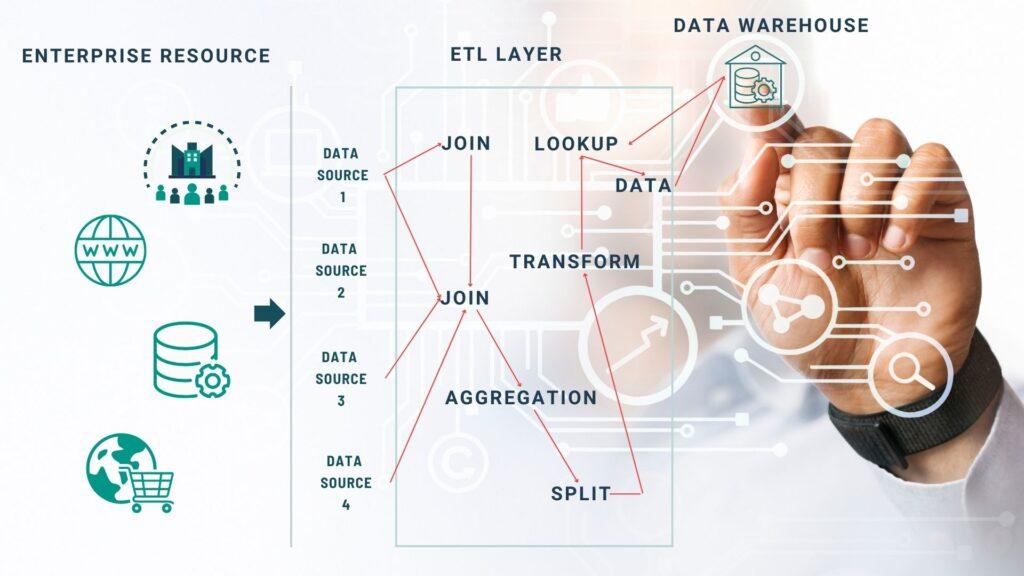In the ever-evolving landscape of data-driven, businesses rely on the ETL (Extract, Transform, Load) process as a foundational pillar. This process acts as an unsung hero, taking raw, disparate data and shaping it into a harmonious symphony ready for analysis and insight generation. But what exactly is data transformation, and why is it essential?
Join us on this journey as we unravel the intricacies of data transformation in the ETL process.

What is the ETL data transformation process?
The data transformation procedure is a step in the extract, transform, and load (ETL) process that gets data ready for analysis. Moreover, at its core, data transformation represents the art of refining, restructuring, and enhancing data to make it suitable for analysis and reporting. It’s the transformative process that bridges the gap between raw data and actionable insights. In simpler terms, think of data transformation as the process of turning a jigsaw puzzle of data pieces into a clear and beautiful picture.
The ETL Process Unveiled
The ETL process, comprising Extraction, Transformation, and Loading, serves as the engine driving data transformation. Before we delve into the depths of data transformation, let’s take a moment to understand the ETL process.
Extraction: Gathering the Ingredients
Identify Data Sources
Imagine you’re a chef preparing a gourmet meal. The first step is to identify the sources of your ingredients. Similarly, in the ETL process, we pinpoint where our data ingredients are coming from. It could be databases, spreadsheets, apps, logs, or even web services.
Connect to Data Sources
Just like a chef selects the perfect utensils, ETL professionals choose the right tools or scripts to connect to these data sources. It’s about setting the stage for the culinary adventure, ensuring we have the right equipment.

Extract Data
Now, picture washing and chopping your ingredients before cooking. We extract data from source systems and temporarily store it in a staging area, our workspace for data cleansing and handling any issues.
Transformation: Shaping the Masterpiece
Data Cleansing
Data needs a thorough cleaning, like washing and peeling veggies. We remove duplicate records, correct errors, and ensure data integrity. Think of this as getting rid of the imperfections in a sculptor’s masterpiece.
Data Validation
We perform rigorous checks to identify inconsistencies or anomalies. Just as a chef ensures all ingredients are fresh and safe, we make sure our data is reliable.
Data Transformation
Much like adjusting your recipe to suit your guests’ preferences, data might need transformations to align with the destination system’s requirements. This can involve converting data types, aggregating, or splitting it.
Data Enrichment
Just as a chef adds unique spices to enhance flavor, we enrich data with information from external sources. This extra context makes the data more valuable and insightful.
Business Rules and Calculations
This is where we add secret ingredients to make our data truly exceptional. Data can undergo business logic and calculations to derive new metrics or indicators necessary for analysis.
Loading: Serving the Finished Dish
Data Staging
Transformed data is temporarily stored in a format optimized for loading into the target data warehouse. It’s like arranging your ingredients neatly on the kitchen counter before cooking.
Data Loading
Now, it’s showtime! Data is loaded from the staging area into the target data warehouse or database. Depending on the ETL process, this can occur in batches or real-time.
Indexing and Optimization
In the data warehouse, we create indexes and data structures to optimize query performance, much like presenting your dish on a beautifully arranged platter.
Refresh Frequency
The frequency of the ETL process varies based on data update frequency and business requirements, just as some dishes are served fresh daily while others are prepared on-demand.
So, there you have it – ETL demystified! It’s like cooking a gourmet meal: you gather the finest ingredients, craft them into a masterpiece, and serve it up beautifully. Additionally, ETL makes data accessible and meaningful, empowering organizations to make informed decisions. The next time you hear about ETL, you’ll have a taste of the culinary artistry behind it.
🔍 In What Cases is Data Transformation Needed?
Data Integration: Bringing Order to Data Chaos
Data transformation plays a crucial role when data resides in multiple sources. It acts as the glue that brings diverse data together into a unified format, ensuring consistency and coherence.
Data Quality Improvement: Polishing the Raw Gem
Data transformation is like a gem cutter. It corrects errors, removes duplicates, and ensures data integrity. Consequently, this leads to better decision-making by providing a clearer and more accurate picture.
Enhanced Analysis: Illuminating Insights
With transformed data, organizations gain the power of enhanced analysis. Consequently, it becomes easier to analyze and explore the data, enabling the extraction of valuable insights that can drive informed decisions.
Customization: Tailoring to Your Needs
Every business has its unique requirements when it comes to data. Data transformation allows businesses to tailor data processing to suit their specific reporting and analysis needs, ensuring that the insights obtained are directly relevant and actionable.
Compliance: Meeting Regulatory Demands
In today’s regulatory landscape, compliance is paramount. Data transformation plays a crucial role in ensuring that data meets regulatory requirements, thus ensuring data accuracy and consistency, and keeping businesses on the right side of the law.
10 Common Types Unveiled of Data Transformation
In the world of data management, data transformation is the unsung hero. But what are the common types of data transformation that you should know about? Let’s dive in.

1. Data Filtering
Data filtering, the simplest of all transformations, acts as your data’s bouncer, allowing only the relevant rows and columns to make it into your data storage. Moreover, ever wonder how clean data makes its way into the warehouse? This is how!
2. Data Mapping
Data mapping, akin to a multilingual translator, takes diverse data inputs and harmonizes them into a unified format. In addition, it’s like turning apples into applesauce, ensuring everything matches – from capitalizations to date formats.
3. Data Deduplication
Data Deduplication, a key aspect of data transformation, helps enhance data quality by identifying and removing duplicate entries. So, this process optimizes storage efficiency and ensures that decision-makers have access to accurate information, promoting more informed and effective organizational decisions.
4. Derived Variables
Derived variables are the data alchemists. They conjure up new attributes from existing data points, opening doors to deeper insights. It’s like turning lead into gold, but with data.
5. Data Sorting
Before data can be your friend, it needs to be sorted. Think of it as organizing your closet by color – it’s easier to find what you need!
6. Data Joining
Data joining is like assembling a dream team. It merges related data elements from various sources into one cohesive unit. In addition, imagine bringing together data from Facebook Ads, Google Ads, and LinkedIn Ads into a single powerhouse table.
7. Data Aggregating
Aggregation groups metrics based on a chosen dimension. It’s like summing up your entire month’s spending into a single figure. Efficiency at its best!
8. Data Splitting
When dealing with complex, unstructured data, splitting is the key. Think of it as dissecting a puzzle to reveal its pieces – street, city, zip code – making it usable.
9. Data Validation
Data validation, the gatekeeper of accuracy, ensures your data is legit. If the first three columns are empty, it says, “No entry!”
10. Data Integration
Data integration provides a common language for your data; by giving every unique data element a passport with a standard name and definition, it allows seamless communication.
Furthermore, data transformation is the backstage hero that makes your data warehouse shine. Understanding these ten common types is like having a secret key to unlocking data’s true potential.
Understanding these ten common types is like having a secret key to unlocking data’s true potential. So, go ahead, transform your data, and let it dazzle your analytics!
Conclusion
Data transformation is the alchemy that turns raw data into gold for businesses. It’s the bridge between chaos and clarity, enabling organizations to make informed decisions and gain a competitive edge. Moreover, in the dynamic world of data, mastering the art of data transformation is a journey worth embarking on.
As a vital part of the ETL process, data transformation empowers organizations to extract meaningful insights, optimize operations, and steer toward a data-driven future. So, embrace the Qmantic power of data transformation, and let your data tell the story of your success.
Explore more about the ETL process by clicking 🔎 here and discover how it can revolutionize your data management and analytics journey.





